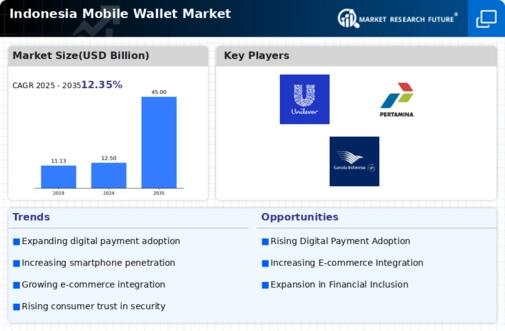Growing E-commerce Sector
The rapid expansion of the e-commerce sector in Indonesia is a significant driver for the mobile wallet market. In 2025, the e-commerce market is projected to reach $50 billion, with a substantial portion of transactions being conducted through mobile wallets. This growth is attributed to changing consumer preferences, where online shopping is becoming increasingly popular. Mobile wallets offer a seamless payment experience, which is essential for e-commerce platforms aiming to enhance customer satisfaction. Additionally, partnerships between mobile wallet providers and e-commerce platforms are likely to increase, further integrating mobile payment solutions into the online shopping experience. The synergy between the growing e-commerce sector and the mobile wallet market is expected to foster innovation and drive transaction volumes.
Increased Consumer Awareness
Consumer awareness regarding the benefits of mobile wallets is on the rise in Indonesia, contributing to the growth of the mobile wallet market. As individuals become more informed about the advantages of digital payments, such as convenience, security, and rewards, the adoption rate is likely to increase. Educational campaigns by mobile wallet providers and financial institutions are playing a crucial role in this awareness drive. In 2025, surveys indicate that over 60% of consumers are aware of mobile wallet functionalities, which is a significant increase from previous years. This heightened awareness is expected to translate into higher usage rates, as consumers seek to leverage the benefits of mobile wallets for everyday transactions. The growing consumer awareness is a vital driver for the mobile wallet market, as it encourages more individuals to transition from cash to digital payments.
Rising Smartphone Penetration
The mobile wallet market in Indonesia is experiencing a notable surge due to the increasing penetration of smartphones. As of 2025, approximately 80% of the population owns a smartphone, facilitating access to mobile wallet applications. This trend indicates a shift in consumer behavior, where individuals prefer digital transactions over traditional cash payments. The convenience offered by mobile wallets, such as instant payments and easy access to financial services, is likely to drive further adoption. Moreover, the proliferation of affordable smartphones has made it easier for a broader demographic to engage with mobile wallet services. This rising smartphone penetration is a critical driver for the mobile wallet market, as it enhances user engagement and expands the potential customer base for service providers.
Government Initiatives for Digital Finance
The Indonesian government is actively promoting digital finance, which significantly impacts the mobile wallet market. Initiatives aimed at enhancing financial inclusion are being implemented, with a target to increase the number of banked individuals. As of 2025, the government has set a goal to have 75% of the population engaged in formal financial services. This push is likely to encourage the adoption of mobile wallets as a means of accessing banking services. Furthermore, regulatory frameworks are being established to support the growth of digital payment systems, ensuring consumer protection and fostering trust in mobile wallet solutions. These government initiatives are pivotal in shaping the mobile wallet market, as they create a conducive environment for innovation and investment.
Technological Advancements in Payment Solutions
Technological advancements are significantly influencing the mobile wallet market in Indonesia. Innovations such as biometric authentication, artificial intelligence, and blockchain technology are enhancing the security and efficiency of mobile payment solutions. As of 2025, many mobile wallet providers are integrating these technologies to offer a more secure and user-friendly experience. For instance, biometric features like fingerprint scanning are becoming standard, providing an additional layer of security that appeals to consumers. Furthermore, the adoption of blockchain technology is likely to streamline transaction processes and reduce costs. These technological advancements not only improve the functionality of mobile wallets but also instill greater confidence among users. As a result, the ongoing evolution of payment technologies is a crucial driver for the mobile wallet market, fostering growth and innovation.














Leave a Comment